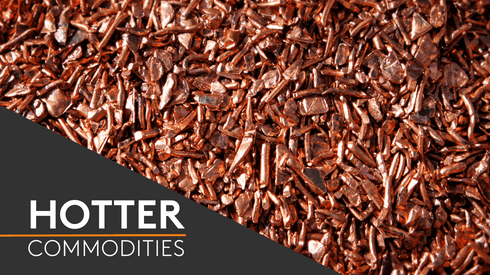The most-traded April copper contract on the SHFE fell to 51,650 yuan ($8,174) per tonne as of 10.23 am Shanghai time, down by 470 yuan or 0.9% from the previous day’s close.
The dollar index touched a high of 90.57 on Thursday, its highest since January 23, and was steady around 90.27 as of 11.13 am Shanghai time, down by just 0.05%, which has pressured the base metals complex this morning.
Adding to the weakness in red metal prices was a 21,125-tonne increase in London Metal Exchange copper stocks on Thursday, with the three-month LME copper price hitting a low of $6,809 per tonne at one point during trading before recovering to $6,845 per tonne – still down by $35 per tonne from the previous day’s close, however.
Furthermore, strong growth in Chinese imports of copper in January have also hit domestic prices due to the higher availability of imported material. Preliminary Chinese customs data showed imports of unwrought copper and copper fabricated products increased by 16.1% last month to 443,000 tonnes.
“However, we see the current weakness as relatively short-lived. Risks of further supply disruptions remain high. And the restriction on copper scrap imports into China is likely to support refined metal imports. This all comes amid broad recovery in economic growth across the globe. Therefore, we maintain our short-term target of $7,200 per tonne,” analysts with ANZ Research said this morning.
“We still see a relatively high level of risk of higher-than-average levels of disruptions due to strikes, despite some successful labor negotiations in recent months. We calculate that there is still over 6 million tonnes of copper mine supply at risk from strike action in South America. Consequently, we have raised our disruption allowance to 6% in 2018 from the normal 5%. This pushes our market balance into a 250,000-tonne deficit in 2018,” the analysts added.
“Furthermore, environmental constraints in China are likely to affect material flow and smelter production. China’s ban on imports of certain copper scrap products could see the amount of copper imported via scrap drop by as much as 200,000 tonnes. China imported 3.6 million tonnes of copper scrap in 2017, up 6.3% from the previous year. As a result, we expect to see China’s copper imports grow higher than the underlying growth in consumption in 2018,” they concluded.
Base metals prices
- The SHFE May nickel contract price fell by 660 yuan or 0.66% to 99,810 yuan per tonne.
- The SHFE March zinc contract price dipped by 70 yuan to 26,185 yuan per tonne.
- The SHFE March aluminium contract price was down by 35 yuan to 14,180 yuan.
- China’s aluminium exports were stronger in January, as Chinese smelters cranked up output following constraints late last year. Exports rose by 14.3% year on year to 445,000 tonnes.
- The SHFE May tin contract price fell by 320 yuan to 149,040 yuan per tonne.
- The SHFE March lead contract price edged down by 5 yuan to 19,075 yuan per tonne.
Currency moves and data releases
- The dollar index was down by 0.05% at 90.26 as of 11.33 am Shanghai time after reaching a high of 90.57 overnight – the highest since January 23.
- In other commodities, the Brent crude oil spot price decreased by 0.08% to $64.25 per barrel, and the Texas light sweet crude oil spot price was down by 0.1% to $60.44.
- In equities, the Shanghai Composite was down by 4.11% to 3,127.92.
- On Thursday, US weekly unemployment claims came in below forecasts at 221,000, below the previous week at 230,000. US equities were under pressure again with the Cboe Volatility Index (VIX) back over 30. Central bankers continue to shrug off recent volatility.
- In data today, China’s consumer inflation cooled to 1.5% in January, in line with expectations, official data showed on Friday. This was down from a 1.8% gain in December. Meanwhile, China’s producer price index (PPI) rose 4.3% from a year earlier, also down from the previous month’s increase of 4.9%, according to the country’s National Bureau of Statistics.
- Later, we have industrial production from Italy, France and the United Kingdom as well as a raft of other UK data including manufacturing production, goods trade balance, construction output and the National Institute of Economic and Social Research’s gross domestic product estimate.
- In addition, Bank of England deputy governor Jon Cunliffe is speaking.
| LME snapshot at 02.22 am London time | ||
| Latest three-month LME Prices | ||
| Price ($ per tonne) | Change since yesterday’s close ($) | |
| Copper | 6,822.50 | -22.5 |
| Aluminium | 2,166.50 | -3.5 |
| Lead | 2,535 | 10.5 |
| Zinc | 3,394 | -27.5 |
| Tin | 21,460 | 135 |
| Nickel | 13,020 | -120 |
| SHFE snapshot at 10.23 am Shanghai time | ||
| Most-traded SHFE contracts | ||
| Price (yuan per tonne) | Change since yesterday’s close (yuan) | |
| Copper | 51,650 | -470 |
| Aluminium | 14,180 | -35 |
| Zinc | 26,185 | -70 |
| Lead | 19,075 | -5 |
| Tin | 149,040 | -320 |
| Nickel | 99,810 | -660 |
| Changjiang spot snapshot on Februa y 9 |
||
| Range (yuan per tonne) | Change (yuan) | |
| Copper | 51,300—51,320 | -330 |
| Aluminium | 13,930—13,970 | -130 |
| Zinc | 26,120—26,920 | -80 |
| Lead | 19,050—19,250 | 0 |
| Tin | 147,500—149,000 | -750 |
| Nickel | 99,150—99,450 | -950 |




